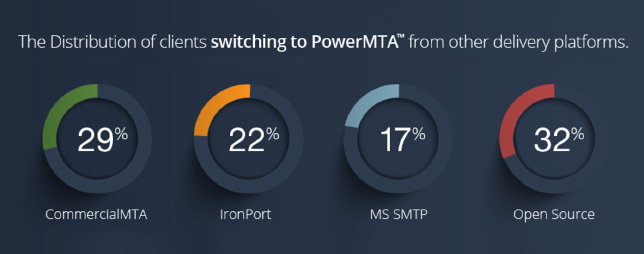


|
||
|
||
Last month I attended the 36th annual M3AAWG conference in San Francisco, where esteemed members of the online messaging and anti-abuse community come together to make the Internet a safer and more secure environment.
The sending community is highly influential especially among Email Service Providers (ESPs) and truly dominated the two-macro conversations that I participated in. These conversations have the industry in somewhat of a transition.
The two issues are partly responsible for transforming other parts of the overall IT ecosystem. The first is the “movement” of IT resources from on-premises solutions to the cloud, and the second is deciding between open source and commercial email infrastructure to power email applications and business processes.
On-premises vs. Cloud
Increasingly on-premises vs. cloud for email is not necessarily an “either / or” decision.
A hybrid email infrastructure solution may make sense for large enterprises as a bi-lateral deployment option in your sending environment. A hybrid cloud is a cloud computing environment that uses a mix of on-premises and cloud resources (public or private) with orchestration between the platforms. Programmatic and agile workloads, and/or distinctive message streams may float across private and public clouds as messaging demands and cost structures change, giving enterprises greater flexibility among deployment platforms.
So how can you determine how best to leverage the strengths of both an on-premises Mail Transfer Agent (MTA) and an outsourced cloud email delivery provider? The key is to maintain a focus on the objectives being pursued and understanding your existing architecture and processes as they pertain to email.
For example, logical reasons for adopting cloud infrastructure may include redundancy and disaster recovery and the ability to quickly “burst up” in capacity without requiring additional internal IT investment. If these are your objectives, you might look at a cloud partner which offers adaptable service level agreements (SLAs) that meets your standards. You should also make sure that the data flow between your on-premises MTA and the cloud is secure and congruent, so confidential information is protected.
 Reporting is another important consideration. In all likelihood your internal email infrastructure will offer a different set of metrics than your cloud delivery solution.
Reporting is another important consideration. In all likelihood your internal email infrastructure will offer a different set of metrics than your cloud delivery solution.
In a hybrid environment, having delivery data in silo’s is a challenge. So getting your cloud delivery service provider to offer blended data sets with your on-premise solution is key. You should understand going in how you will consolidate and standardize the data so that visibility is maintained into your overall email performance. Both front-end and back-end delivery analytics are at play among dozens of important metrics.
Port25 Data Snippet: The graphic to the right depicts US based cloud email infrastructure “interest” among five hourly volume buckets. While there is some cloud interest among senders that send more than 1M per hour, 61% of our evaluation requests, have expressed interest in cloud-infrastructure that send between 50K hourly messages or less.
Open Source vs. Commercial MTAs
In regards to Open Source vs Commercial MTAs, there is considerable traction towards commercial MTAs. Early stage ESPs which implemented various forms of “open source” MTAs which go by various names, including postfix, sendmail, qmail, Exim, have grown out of these platforms and onto more sophisticated platforms. Within the Port25 sending ecosystem, many ESPs and Enterprises are upgrading their sending platforms from open source MTAs and have invested in commercially-supported solutions for higher performance and ease of operation and configuration.
Sheer delivery speed is one big reason and access to more granular delivery controls is another. Originally, open source MTAs were never designed to be high-performance delivery workhorses. Rather, they were created to perform more traditional tasks such as email account management. ESPs and enterprises that still use this somewhat dated architecture usually need to build elaborate, proprietary, and complex server cluster farms to achieve tolerable performance in today’s hyper-competitive delivery market.
To achieve capable scaling with an open source MTA an organization needs to build a highly complicated cluster of instances or nodes. Newer commercial solutions have been designed to scale “out of the box”, such that a single server instance can reliably deliver millions of messages an hour if needed. These servers can be expanded linearly (load balanced) so that the ESP or enterprise can deliver several orders of magnitude more email in a short time frame.
Ease of configuration is a big differentiator between open source and commercial MTAs along with much more sophisticated bounce categorization. The amount of time and level of effort required to complete normal management tasks (for example spawning new instances as ESPs bring on new clients, or making sure new IP addresses are properly warmed, maintaining per stream delivery settings, etc.) quickly adds up when working with customized code.
The potential investment of man hours can be cost prohibitive and a major liability.
Ongoing maintenance and upgrades also are important considerations. With a highly customized sending infrastructure, open source MTA code must be continually tweaked by admins and engineers each time an update is required. This constraint makes it difficult to keep pace with changes happening within the dynamic email delivery ecosystem.
Open source software can sometimes foster a knowledge transfer challenge as well. This can be a very under-estimated issue for infrastructure maintenance. How many members of the company’s technical group really understand how the delivery infrastructure operates? Is there just a handful of system admins who truly understand the current open-source set up? What if that person or persons left, through a layoff or by being poached by a competitor? Often times all the specialized aspects of the infrastructure have not been properly documented, and new employees cannot easily access and understand the information.
Because of these and other considerations, ESPs and enterprises continue to inquire about and ultimately adopt a commercial MTA platform. Here at Port25, the graphic below shows the platform our customers were using prior to adopting our PowerMTA gateway:

The considerations above are just some of the challenges facing senders today. Email has never been more important to online success, and ESPs and enterprises need to stay one step ahead of ISP requirements and new authentication policies such as SPF and DKIM and DMARC. Authentication is a critical issue to get right—for example, 94 percent of all email sent to Gmail uses two methods of authentication.
When deciding on the best email infrastructure for your enterprise, make sure the email technology partner you choose has a track record of proven on-premises success and a cloud-based offering to conjugate hybrid delivery opportunities, which most on-premises providers have today. That’s the way to stay successful through this period of email transition in the Email Infrastructure space.
Sponsored byVerisign

Sponsored byRadix

Sponsored byDNIB.com

Sponsored byWhoisXML API

Sponsored byCSC

Sponsored byIPv4.Global

Sponsored byVerisign
